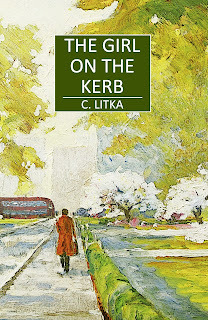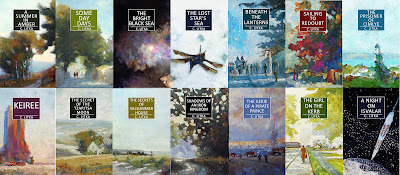Launching The Girl on the Kerb (Part 1)
 The Cover of a Cozy Thriller
The Cover of a Cozy ThrillerLast week I talked about my new appreciation for my role as thepublisher of my work. This week I am going to continue along thoselines, talking about the launch of my new novel, The Girl on theKerb.
(Edit – I’mnever in any danger of writing anything too briefly. I waffle on andon, and I do so here as well. I had intended this to be a single piece,but after including everything I thought I needed to include to fullyexplain the launching of the Girlon the Kerb, I found the word count approaching 1000 words,and I hadn’t even reached the actual launch yet. It was only thenwhen I decided to split this report into two parts. Seeing that Ihave nothing else in mind to write about, save my April book report,it was an easy decision.)
First, somebackground. By the time March had rolled around, I had learned enoughabout traditional publishing to decide that I didn’t want to sellmy story to a traditional publisher. This was easy to decide, since Ihadn’t been asked. However, the thought of losing effective controlof my work, just stuck in my gullet even though I had no expectationthat Gollancz would actually buy it. Still, I promised myself to waiton their rejection before publishing it myself. It was part of thegame I was playing. They had said that the process would take 6 to 9months, and March was the ninth month… I had only to wait it outbefore I could consider my promise kept.
Nevertheless, Idecided to cheat. Just a little. Given my feelings about traditionalpublishing, I felt safe, on 11 March, to put the ebook version of thestory up for pre-order on Amazon for a 6 April release. Beingslightly superstitious, I always releasing my books on a Thursday,and that was the first Thursday in April. I told myself that I couldcancel the pre-order if the impossible happened and I changed mymind. I then took a step further. Not wishing to wait until mid tolate April for my author copies of the paperback book, I quietlyreleased the paper version of the book on 11 March. Almost no onebuys paper copies of my books, so I figured it hardly counted as arelease.
As it turned out, Ireceived my rejection from Gollancz on the 24th of March.I know of several writers who passed this first process, and hadtheir stories go on to the second round consideration – that wouldtake another three months. Oh, the hoops publishers put poor writersthrough – because they know any writer will do just about anything,and accept just about any deal, to get published.
With nothing holdingme back, I decided to release the Smashwords and Google ebook andaudiobook versions on the following Thursday, 30 March.
My next decision waswhat to release The Girl on the Kerb as. As in what categoryor genre it would be slotted under. Using the freedom andopportunities afforded by being my own publisher, I decided torelease The Girl on the Kerbas something other thana science fiction novel.
There as a number ofreasons for this. The first being that during my time posing as anaspiring traditional writer, I discovered that though I could findagents who said they were willing to take on science fiction, whatthey really seemed to be looking for was fantasy. Indeed, I watchedan interview with an agent who confirmed this, saying that publisherswere far more anxious to find fantasy than SF. That suggested to me that SF wasn't all that hot. And even in author publishing, fantasy outsells SF by a fair amount.
Still, there are a lot of author published SF books on Amazon, but much ofit is military SF in one guise or another. Military SF is the largestsingle category, but when you consider that Space Opera, FirstContact, Alien Invasion, as well as Adventure all usually featurewars of some sort, that’s more than half of the SF titles. Thissuggests that military SF in its various guises is what most AmazonSF fans want to read. Since my story isn’t military SF, releasingit as SF would mean that it would likely only appeal to my usualreaders. Which is fine… But if I could find some way to find somemore readers...
A second reason fornot releasing it as SF is that over the last couple of years I’vehad my own personal epiphany. I’ve had to admit to myself thatdespite considering myself a SF fan almost all my life, after readingSF blogs and watching SF YouTube videos, I've come to realize that I really don’t like mostSF stories. On any list of 100 great SF books, I may’ve read, ortried to read, 17 of them. Of course, I’ve slotted almost all of mybooks into SF, because they are all set in the future, and most onother planets. But that, in part, is due to sheer laziness on my part; itmeans that I don’t have to do the research needed to write a storyin real places at real times, I could just make up things as I goalong. But thinking about it, is the setting what really matters? What if Ireleased it in accordance to its plot rather than its setting?
If I wanted to findnew readers, and as a publisher, I do, it seemed to me that I wouldhave to offer something new to find new readers. I had tried thisbefore, writing and releasing Beneath the Lanterns as fantasy without, I must admit, any great success in breaking into the fantasy market. However, I’m hoping to rectify that this year… butthat’s a subject for another post. Still, I had to believe that it was worth trying again. In this case, I decidedto release The Girl on the Kerb based on its plot, by listingit as an espionage novel instead of a SF novel. I figured I could dothis, just as long as I made it clear in the blurb that the story wasset in the far future, i.e. they were getting an espionage novel witha SF twist.
Having decided onthis course of action, I discovered, when setting up the book, thatespionage novels are not a separate category. Rather, they are asub-category of “thrillers”. This, I must admit, gave me a bit ofa pause. I hadn’t written a thriller. Or at least, I didn’t thinkI had. Though not being a reader of thrillers, I couldn’t say oneway or another. Perhaps there are such things as “cozy thrillers.”Well, if not, I guess I’ve gone and invented them with The Girlon the Kerb. In any event, I decided to go with “Thriller –espionage” and double down with “Thriller – adventure” forits category/genre. No mention of SF at all. Nothing ventured,nothing gained.
So how has it gone?That’s next week’s subject. Stay tuned.




